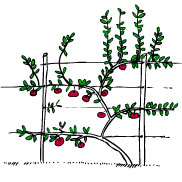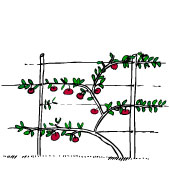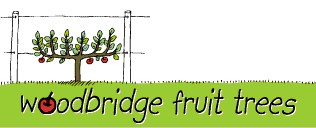No products
 View larger
View larger
Pruning - summer and winter
by Nik Magnus | © 2016 Woodbridge Fruit Trees | www.woodbridgefruittrees.com.au
Pruning is something most people know needs to be done, and that leads to two groups. Those who get seccatuers out and just hack because it the done thing, and those who cut into a tree, knowing why they're doing it, how to do it and are confident on the end result. Hopefully this article will help the reader move from the former camp and into the latter.
Having said that, there are as many different systems to prune as there are horticulturalists, and not only are the methods equally valid, but each would approach the same tree differently. Confused? The key is to realise that there are many ways to do it, and don't be scared to make mistakes because we all do.
Consider first an unpruned tree that's left to do as nature intended. After 5-10 years it will become a tall, dense tree that bears increasingly less fruit but has a lot of vertical growth and leaves. Perhaps it has reached a level of comfort and doesn't need to reproduce knowing it's healthy and content, hence producing only few fruit. By pruning a tree perhaps it feels just a little threatened so it responds with trying to produce masses of off-spring (fruit) to our advantage. By repeated seasonal pruning, we can keep the tree in a fruiting cycle rather than an unproductive vegetative cycle.
Why do we prune?
For a few different purposes, and at different times.
- Shaping the tree when planting
- Removing dead wood and diseased / damaged limbs
- Encouraging fruiting and increasing access to fruit.
- Increasing light into the centre of the tree
- Ability to fit the tree into an existing garden design.
Apical Dominance.
The key to knowing where the growth occurs lies in the hormone auxin produced by the actively growing tips of branches, which acts to inhibit buds from sprouting closer to the trunk. The result of this system is called apical dominance whereby the growth occurs at the top of the tree and the outer branches, allowing it to get bigger and wider and denser. Cutting the limb takes away that inhibition and allows the end buds to shoot, causing branching where the cut has occurred. The second thing to remember is that growth is usually vertical and occurs on the tips of vertical shoots, extending it, and along the length of a horizontal branch.
Shaping the tree when planting.
When the tree is first planted, it's important to have decided what shape you would like. For an espalier, prune it at the first wire so as to get it to branch at that point. For an open tree, cut it at the point that you wish the trunk to end and the tree to start branching. For a a spindle bush, leave the central leader in tact. By pruning, we are able to influence the shape of the tree, for example in an open vase shape, pruning the trunk at 50cm from the ground allows 2-4 shoots to form which will be later bent out to form the basis of the open tree. If the tree is left unpruned for example to a height of 1.5m, growth and branches would more likely occur at the top of the tree, and laterals lower down on the tree will be less substantial if at all
Even as the tree matures, the shape and size can be guided by careful pruning. By selecting which limbs should stay and which should be removes, one can choose between a narrow upright tree, a lower wider tree, an espalier, just to name a few.
Removing dead wood and diseased limbs.
When limbs die, they rot and this can spread into the trunk and other branches. Similarly a branch damaged by wind, possums, or other means will have wound with a large surface area.. Making a clean pruning cut and applying some wound paint will minimise dieback and close off the entry of diseases that could further damage the tree. Any dead wood should be careful pruned off and larger wounds (>1cm) painted with wound paint.
Encouraging Fruiting and increasing access fruit.
A tall tree may require a ladder to reach the high fruit, while a wider or espaliered tree may be a lot easier to pick. The vertical growth tends to be more focused on producing more growth, while angled limbs tend to form fruiting spurs. This can be achieved by a combination of pruning cuts or bending limbs outwards to encourage a wider rather than taller tree. In this way, the energy that would have been used to make more growth can be put into growing fruit.
Reducing the vertical growth can also allow more light to penetrate the centre of the tree which would generally become thick and cluttered, allowing easier access to the centre of the tree.
Ability to fit the tree into an existing garden design.
Perhaps there is space for a large round 4m diameter plum tree, or maybe only a spot for a 1.5m wide espaliered apple tree along a fence. Careful pruning can adapt the tree to the available spaces.
Summer Pruning.
This is an excellent system of pruning and is done after the summer growth has abated, and the new growth has hardened a little. Usually late summer or early Autumn.
Keep in mind your chosen shape of the tree and the number of leaders. Thin out excess vertical growth and bend kept verticals out to become angled branches. This can be done using string and pegs into the ground, weights hung from branches or struts between branches to hold them apart. Obviously a trellis is the most efficient way to tie down limbs. When pruning, cut verticals off at to 3-4 buds, hopefully promoting fruiting spurs.
The advantage of summer pruning is that the energy of the plant goes into the fruit rather than into the growth, plus it lets more light into the tree for ripening. Timing is important, if pruning is done too early (eg late spring and early summer), the tree may react by producing more growth and putting less energy into the fruit: the opposite to what is trying to be achieved. Sometimes there is a little more growth that occurs after summer pruning, but generally it's only a small amount.


image: before and after summer pruning
Winter Pruning.
When the tree is dormant it can be safely pruned as no growth will occur until Spring. The advantage of having no leaves on the tree allows the shape of the limbs and growth to be seen more easily. Apart from that, the technique is much the same as in summer pruning.
Tasks to complete when pruning
- remove all suckers from the roots and shoots from below the graft
- choose new leaders (eg in an espalier or new branches in an open vase) and bend them into new positions.
- remove excess growth to 2-3 buds
- remove dead or diseased wood and paint with wound paint.
Re-working an old unpruned tree
This can be an overwhelming task, considering that the tree has been in a growth cycle for years rather than a fruiting cycle.
If pruned severely, it will just react with excessive growth and a better approach is to prune half of the growth out the first year. The following year bend some of the new shoots outwards forming a new framework of open limbs, at the same time removing remainder of the old growth. Be prepared for some strong growth though, and don't expect it to settle for 2-3 years. Radical pruning can easily kill a tree.
This product is no longer in stock
by Nik Magnus | © 2016 Woodbridge Fruit Trees | www.woodbridgefruittrees.com.au
Pruning is something most people know needs to be done, and that leads to two groups. Those who get seccatuers out and just hack because it the done thing, and those who cut into a tree, knowing why they're doing it, how to do it and are confident on the end result. Hopefully this article will help the reader move from the former camp and into the latter.
Having said that, there are as many different systems to prune as there are horticulturalists, and not only are the methods equally valid, but each would approach the same tree differently. Confused? The key is to realise that there are many ways to do it, and don't be scared to make mistakes because we all do.
Consider first an unpruned tree that's left to do as nature intended. After 5-10 years it will become a tall, dense tree that bears increasingly less fruit but has a lot of vertical growth and leaves. Perhaps it has reached a level of comfort and doesn't need to reproduce knowing it's healthy and content, hence producing only few fruit. By pruning a tree perhaps it feels just a little threatened so it responds with trying to produce masses of off-spring (fruit) to our advantage. By repeated seasonal pruning, we can keep the tree in a fruiting cycle rather than an unproductive vegetative cycle.
Why do we prune?
For a few different purposes, and at different times.
- Shaping the tree when planting
- Removing dead wood and diseased / damaged limbs
- Encouraging fruiting and increasing access to fruit.
- Increasing light into the centre of the tree
- Ability to fit the tree into an existing garden design.
Apical Dominance.
The key to knowing where the growth occurs lies in the hormone auxin produced by the actively growing tips of branches, which acts to inhibit buds from sprouting closer to the trunk. The result of this system is called apical dominance whereby the growth occurs at the top of the tree and the outer branches, allowing it to get bigger and wider and denser. Cutting the limb takes away that inhibition and allows the end buds to shoot, causing branching where the cut has occurred. The second thing to remember is that growth is usually vertical and occurs on the tips of vertical shoots, extending it, and along the length of a horizontal branch.
Shaping the tree when planting.
When the tree is first planted, it's important to have decided what shape you would like. For an espalier, prune it at the first wire so as to get it to branch at that point. For an open tree, cut it at the point that you wish the trunk to end and the tree to start branching. For a a spindle bush, leave the central leader in tact. By pruning, we are able to influence the shape of the tree, for example in an open vase shape, pruning the trunk at 50cm from the ground allows 2-4 shoots to form which will be later bent out to form the basis of the open tree. If the tree is left unpruned for example to a height of 1.5m, growth and branches would more likely occur at the top of the tree, and laterals lower down on the tree will be less substantial if at all
Even as the tree matures, the shape and size can be guided by careful pruning. By selecting which limbs should stay and which should be removes, one can choose between a narrow upright tree, a lower wider tree, an espalier, just to name a few.
Removing dead wood and diseased limbs.
When limbs die, they rot and this can spread into the trunk and other branches. Similarly a branch damaged by wind, possums, or other means will have wound with a large surface area.. Making a clean pruning cut and applying some wound paint will minimise dieback and close off the entry of diseases that could further damage the tree. Any dead wood should be careful pruned off and larger wounds (>1cm) painted with wound paint.
Encouraging Fruiting and increasing access fruit.
A tall tree may require a ladder to reach the high fruit, while a wider or espaliered tree may be a lot easier to pick. The vertical growth tends to be more focused on producing more growth, while angled limbs tend to form fruiting spurs. This can be achieved by a combination of pruning cuts or bending limbs outwards to encourage a wider rather than taller tree. In this way, the energy that would have been used to make more growth can be put into growing fruit.
Reducing the vertical growth can also allow more light to penetrate the centre of the tree which would generally become thick and cluttered, allowing easier access to the centre of the tree.
Ability to fit the tree into an existing garden design.
Perhaps there is space for a large round 4m diameter plum tree, or maybe only a spot for a 1.5m wide espaliered apple tree along a fence. Careful pruning can adapt the tree to the available spaces.
Summer Pruning.
This is an excellent system of pruning and is done after the summer growth has abated, and the new growth has hardened a little. Usually late summer or early Autumn.
Keep in mind your chosen shape of the tree and the number of leaders. Thin out excess vertical growth and bend kept verticals out to become angled branches. This can be done using string and pegs into the ground, weights hung from branches or struts between branches to hold them apart. Obviously a trellis is the most efficient way to tie down limbs. When pruning, cut verticals off at to 3-4 buds, hopefully promoting fruiting spurs.
The advantage of summer pruning is that the energy of the plant goes into the fruit rather than into the growth, plus it lets more light into the tree for ripening. Timing is important, if pruning is done too early (eg late spring and early summer), the tree may react by producing more growth and putting less energy into the fruit: the opposite to what is trying to be achieved. Sometimes there is a little more growth that occurs after summer pruning, but generally it's only a small amount.


image: before and after summer pruning
Winter Pruning.
When the tree is dormant it can be safely pruned as no growth will occur until Spring. The advantage of having no leaves on the tree allows the shape of the limbs and growth to be seen more easily. Apart from that, the technique is much the same as in summer pruning.
Tasks to complete when pruning
- remove all suckers from the roots and shoots from below the graft
- choose new leaders (eg in an espalier or new branches in an open vase) and bend them into new positions.
- remove excess growth to 2-3 buds
- remove dead or diseased wood and paint with wound paint.
Re-working an old unpruned tree
This can be an overwhelming task, considering that the tree has been in a growth cycle for years rather than a fruiting cycle.
If pruned severely, it will just react with excessive growth and a better approach is to prune half of the growth out the first year. The following year bend some of the new shoots outwards forming a new framework of open limbs, at the same time removing remainder of the old growth. Be prepared for some strong growth though, and don't expect it to settle for 2-3 years. Radical pruning can easily kill a tree.
Reviews
No customer reviews for the moment.

